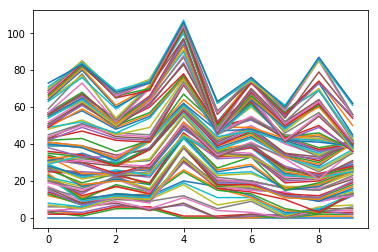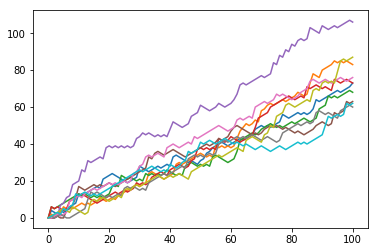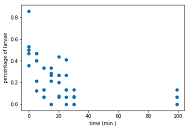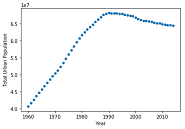Intermediate Python for Data Science
This notebook contains most of the essential elements of Python skill for data science. While you go through it, you will learn about
- how to use matplotlib to visualize data
- how to use pandas dataframe, read and manupulate data
- Dictionaries
- logic control flows
- loop
- Random walk - A case study.
Matplotlib
import numpy as np
import matplotlib.pyplot as plt
import pandas as pd
year = [1950, 1970, 1990, 2010]
pop = [2.519, 3.69, 5.263, 6.972]
# line plot
plt.plot(year, pop)
plt.xlabel("Year")
plt.ylabel("Population (billion)")
plt.show()
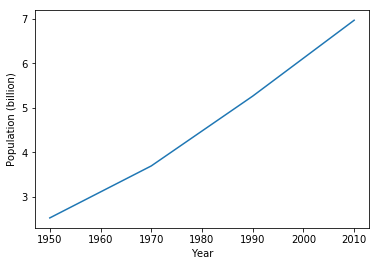
# Scatter PLot
plt.scatter(year, pop)
plt.xlabel("Year")
plt.ylabel("Population (billion)")
plt.show()
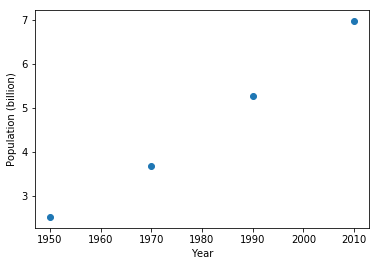
data = pd.read_csv("data/worldpop.csv")
data.head()
| Unnamed: 0 | country | year | population | cont | life_exp | gdp_cap | |
|---|---|---|---|---|---|---|---|
| 0 | 11 | Afghanistan | 2007 | 31889923.0 | Asia | 43.828 | 974.580338 |
| 1 | 23 | Albania | 2007 | 3600523.0 | Europe | 76.423 | 5937.029526 |
| 2 | 35 | Algeria | 2007 | 33333216.0 | Africa | 72.301 | 6223.367465 |
| 3 | 47 | Angola | 2007 | 12420476.0 | Africa | 42.731 | 4797.231267 |
| 4 | 59 | Argentina | 2007 | 40301927.0 | Americas | 75.320 | 12779.379640 |
pop = data["population"]
gdp = data["gdp_cap"]
# Line PLot
plt.plot(pop, gdp)
plt.xlabel("Population")
plt.ylabel("GDP")
plt.show()
# Scatter PLot
plt.scatter(pop, gdp)
plt.xlabel("Population")
plt.ylabel("Population (")
plt.show()
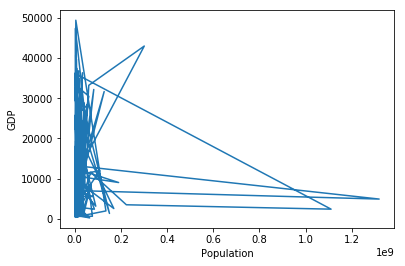
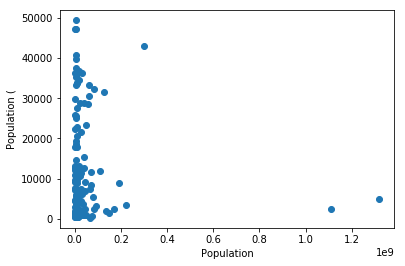
Histogram
life_exp = data["life_exp"]
plt.title("Histogram with 15 bins")
plt.hist(life_exp, bins=15)
plt.show()
# to clean up plot
plt.clf()
plt.title("Histogram with 5 bins")
plt.hist(life_exp, bins=5)
plt.show()
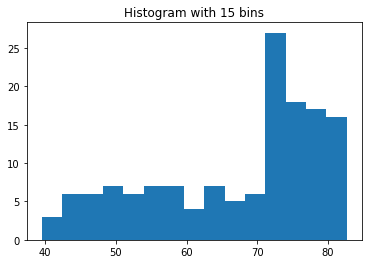
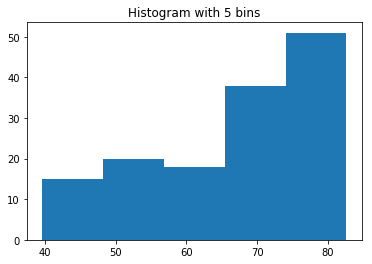
# basic scatter
# Scatter plot
plt.scatter(gdp, life_exp)
# Previous customizations
plt.xscale('log')
plt.xlabel('GDP per Capita [in USD]')
plt.ylabel('Life Expectancy [in years]')
plt.title('World Development in 2007')
# Definition of tick_val and tick_lab
tick_val = [1000, 10000, 100000]
tick_lab = ['1k', '10k', '100k']
# Adapt the ticks on the x-axis
plt.xticks(tick_val, tick_lab)
# After customizing, display the plot
plt.show()
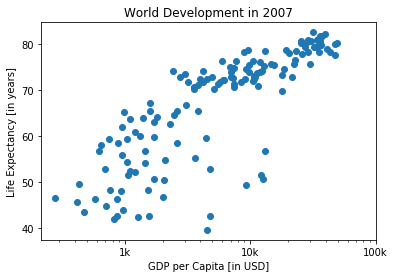
Dictionaries and Pandas
# Definition of dictionary
europe = {'spain':'madrid', 'france':'paris', 'germany':'berlin', 'norway':'oslo' }
# Print out the keys in europe
print(europe.keys(), '\n')
# Print out value that belongs to key 'norway'
print(europe['norway'])
dict_keys(['spain', 'france', 'germany', 'norway'])
oslo
# Build cars DataFrame
names = ['United States', 'Australia', 'Japan', 'India', 'Russia', 'Morocco', 'Egypt']
dr = [True, False, False, False, True, True, True]
cpc = [809, 731, 588, 18, 200, 70, 45]
dict = { 'country':names, 'drives_right':dr, 'cars_per_cap':cpc }
cars = pd.DataFrame(dict)
print(cars,"\n\n")
# Definition of row_labels
row_labels = ['US', 'AUS', 'JAP', 'IN', 'RU', 'MOR', 'EG']
# Specify row labels of cars
cars.index = row_labels
# Print cars again
print(cars)
country drives_right cars_per_cap
0 United States True 809
1 Australia False 731
2 Japan False 588
3 India False 18
4 Russia True 200
5 Morocco True 70
6 Egypt True 45
country drives_right cars_per_cap
US United States True 809
AUS Australia False 731
JAP Japan False 588
IN India False 18
RU Russia True 200
MOR Morocco True 70
EG Egypt True 45
# to read data
brics = pd.read_csv("data/brics.csv", index_col = 0)
# to print data
print("Our brics dataset....\n")
print(brics, "\n\n")
# return pandas series
print("Printing pandas series...\n")
print(brics["country"], "\n\n")
# return pandas dataframe
print("Printing pandas dataframe...\n")
print(brics[["country"]],"\n\n")
# multiple dataframes
print("Printing multiple dataframes...\n")
print(brics[["country", "population"]],"\n\n")
# Multiple dataframes with index
print("Printing multiple dataframes with indexing...\n")
print(brics[1:4])
Our brics dataset....
country capital area population
BR Brazil Brasilia 8.516 200.40
RU Russia Moscow 17.100 143.50
IN India New Delhi 3.286 1252.00
CH China Beijing 9.597 1357.00
SA South Africa Pretoria 1.221 52.98
Printing pandas series...
BR Brazil
RU Russia
IN India
CH China
SA South Africa
Name: country, dtype: object
Printing pandas dataframe...
country
BR Brazil
RU Russia
IN India
CH China
SA South Africa
Printing multiple dataframes...
country population
BR Brazil 200.40
RU Russia 143.50
IN India 1252.00
CH China 1357.00
SA South Africa 52.98
Printing multiple dataframes with indexing...
country capital area population
RU Russia Moscow 17.100 143.5
IN India New Delhi 3.286 1252.0
CH China Beijing 9.597 1357.0
# Row access: loc
print("Row access pandas series\n")
print(brics.loc["IN"],"\n\n")
print("Row access pandas dataframe\n")
print(brics.loc[["IN"]],"\n\n")
print("Multple Row access\n")
print(brics.loc[["IN", "CH", "SA"]],"\n\n")
print("Rows with specific column\n")
print(brics.loc[["RU", "IN","SA"], ["country", "capital"]])
Row access pandas series
country India
capital New Delhi
area 3.286
population 1252
Name: IN, dtype: object
Row access pandas dataframe
country capital area population
IN India New Delhi 3.286 1252.0
Multple Row access
country capital area population
IN India New Delhi 3.286 1252.00
CH China Beijing 9.597 1357.00
SA South Africa Pretoria 1.221 52.98
Rows with specific column
country capital
RU Russia Moscow
IN India New Delhi
SA South Africa Pretoria
# iloc
print("Row access pandas dataframe\n")
print(brics.iloc[[1]],"\n\n")
print("Multple Row access\n")
print(brics.iloc[[1, 2, 4]],"\n\n")
print("Rows with specific column\n")
print(brics.iloc[[1, 2, 4], :3])
Row access pandas dataframe
country capital area population
RU Russia Moscow 17.1 143.5
Multple Row access
country capital area population
RU Russia Moscow 17.100 143.50
IN India New Delhi 3.286 1252.00
SA South Africa Pretoria 1.221 52.98
Rows with specific column
country capital area
RU Russia Moscow 17.100
IN India New Delhi 3.286
SA South Africa Pretoria 1.221
Logic Control flow and filtering
my_house = np.array([18.0, 20.0, 10.75, 9.50])
your_house = np.array([14.0, 24.0, 14.25, 9.0])
# my_house greater than 18.5 or smaller than 10
print(np.logical_or(my_house > 18.5, my_house < 10))
# Both my_house and your_house smaller than 11
print(np.logical_and(my_house < 11, your_house < 11))
print(my_house)
[False True False True]
[False False False True]
[18. 20. 10.75 9.5 ]
cars = pd.read_csv('data/cars.csv', index_col = 0)
# Extract drives_right column as Series: dr
dr = cars["drives_right"]
# Use dr to subset cars: sel
sel = cars[dr]
# Print sel
print(sel)
cars_per_cap country drives_right
US 809 United States True
RU 200 Russia True
MOR 70 Morocco True
EG 45 Egypt True
# Create car_maniac: observations that have a cars_per_cap over 500
cpc = cars['cars_per_cap']
car_maniac = cpc > 500
print("Cars dataset more than 500 cars ..\n\n",cars[car_maniac])
Cars dataset more than 500 cars ..
cars_per_cap country drives_right
US 809 United States True
AUS 731 Australia False
JAP 588 Japan False
between = np.logical_and(cpc > 100, cpc < 500)
medium = cars[between]
print("Cars dataset with cars between 100 and 500 cars per capital..\n\n", medium)
Cars dataset with cars between 100 and 500 cars per capital..
cars_per_cap country drives_right
RU 200 Russia True
Loop
# while loop
x = 10
while x > 0:
print("x is now: ", x)
x = x - 2
x is now: 10
x is now: 8
x is now: 6
x is now: 4
x is now: 2
# for loop
# areas list
areas = [11.25, 18.0, 20.0, 10.75, 9.50]
for area in areas:
print(area)
print("\nenumerate: looping with index\n")
for index, area in enumerate(areas):
print("Area ", index, ": ", area)
11.25
18.0
20.0
10.75
9.5
enumerate: looping with index
Area 0 : 11.25
Area 1 : 18.0
Area 2 : 20.0
Area 3 : 10.75
Area 4 : 9.5
# house list of lists
house = [["hallway", 11.25],
["kitchen", 18.0],
["living room", 20.0],
["bedroom", 10.75],
["bathroom", 9.50]]
# Build a for loop from scratch
for room in house:
print("the " + room[0] + " is " + str(room[1]) + " sqm" )
the hallway is 11.25 sqm
the kitchen is 18.0 sqm
the living room is 20.0 sqm
the bedroom is 10.75 sqm
the bathroom is 9.5 sqm
# iterate over dictionary
# Definition of dictionary
europe = {'spain':'madrid', 'france':'paris', 'germany':'berlin',
'norway':'oslo', 'italy':'rome', 'poland':'warsaw', 'austria':'vienna' }
# Iterate over europe
for country, capital in europe.items():
print("The capital of ", country, " is ", capital)
The capital of spain is madrid
The capital of france is paris
The capital of germany is berlin
The capital of norway is oslo
The capital of italy is rome
The capital of poland is warsaw
The capital of austria is vienna
# looping over n dimensional numpy array
np_height = np.array([[23, 40, 55], [55, 90, 11]])
for height in np.nditer(np_height):
print(height)
23
40
55
55
90
11
# looping over pandas dataframe
cars = pd.read_csv('data/cars.csv', index_col = 0)
# Iterate over rows of cars
for lab, row in cars.iterrows() :
print(lab, ": ",row['cars_per_cap'] )
US : 809
AUS : 731
JAP : 588
IN : 18
RU : 200
MOR : 70
EG : 45
# adding new rows
cars["Name_lenght"] = cars['country'].apply(len)
print(cars)
cars_per_cap country drives_right Name_lenght
US 809 United States True 13
AUS 731 Australia False 9
JAP 588 Japan False 5
IN 18 India False 5
RU 200 Russia True 6
MOR 70 Morocco True 7
EG 45 Egypt True 5
Case Study: Hacker Statistics
Random Walk
A random walk is a mathematical object, known as a stochastic or random process, that describes a path that consists of a succession of random steps on some mathematical space such as the integers.
np.random.seed(123)
random_walk = [0]
for x in range(100) :
step = random_walk[-1]
dice = np.random.randint(1,7)
if dice <= 2:
# Replace below: use max to make sure step can't go below 0
step = max(0,step - 1)
elif dice <= 5:
step = max(0, step + 1)
else:
step = max(0, step + np.random.randint(1,7))
random_walk.append(step)
print(random_walk)
[0, 3, 4, 5, 4, 5, 6, 7, 6, 5, 4, 3, 2, 1, 0, 0, 1, 6, 5, 4, 5, 4, 5, 6, 7, 8, 9, 8, 9, 8, 9, 10, 11, 12, 11, 15, 16, 15, 16, 15, 16, 17, 18, 19, 20, 21, 22, 25, 26, 27, 28, 33, 34, 38, 39, 38, 39, 40, 39, 40, 41, 43, 44, 45, 44, 43, 44, 45, 44, 43, 44, 45, 47, 46, 45, 46, 45, 46, 47, 48, 50, 49, 50, 51, 52, 53, 54, 53, 52, 53, 52, 53, 54, 53, 56, 57, 58, 59, 58, 59, 60]
# visualization random walk
plt.plot(random_walk)
plt.title("Random walk")
plt.show()
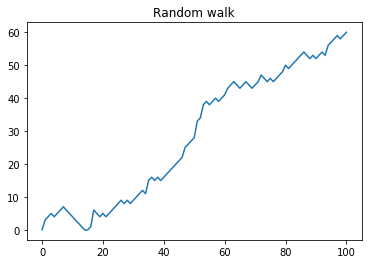
# visualization random walk
plt.hist(random_walk, bins = 15)
plt.title("Random walk")
plt.show()
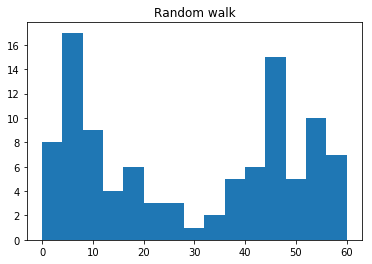
# Distribution
# initialize and populate all_walks
all_walks = []
for i in range(10) :
random_walk = [0]
for x in range(100) :
step = random_walk[-1]
dice = np.random.randint(1,7)
if dice <= 2:
step = max(0, step - 1)
elif dice <= 5:
step = step + 1
else:
step = step + np.random.randint(1,7)
random_walk.append(step)
all_walks.append(random_walk)
# Convert all_walks to Numpy array: np_aw
np_aw = np.array(all_walks)
# Plot np_aw and show
plt.plot(np_aw)
plt.show()
# Clear the figure
plt.clf()
# Transpose np_aw: np_aw_t
np_aw_t = np_aw.T
# Plot np_aw_t and show
plt.plot(np_aw_t)
plt.show()
